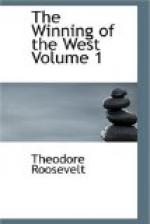For food they used all these vegetables, as well as beef and pork, and venison stewed in bear’s oil; they had hominy and corn-cakes, and a cool drink made from honey and water,[21] besides another made from fermented corn, which tasted much like cider.[22] They sifted their flour in wicker-work sieves, and baked the bread in kettles or on broad, thin stones. Moreover, they gathered the wild fruits, strawberries, grapes, and plums, in their season, and out of the hickory-nuts they made a thick, oily paste, called the hickory milk.
Each town was built round a square, in which the old men lounged all day long, gossiping and wrangling. Fronting the square, and surrounding it, were the four long, low communal houses, eight feet high, sixteen feet deep, and forty to sixty in length. They were wooden frames, supported on pine posts, with roof-tree and rafters of hickory. Their fronts were open piazzas, their sides were lathed and plastered, sometimes with white marl, sometimes with reddish clay, and they had plank doors and were roofed neatly with cypress bark or clapboards. The eave boards were of soft poplar. The barrier towns, near white or Indian enemies, had log houses, with portholes cut in the walls.
The communal houses were each divided into three rooms. The House of the Micos, or Chiefs and Headmen, was painted red and fronted the rising sun; it was highest in rank. The Houses of the Warriors and the Beloved Men—this last being painted white—fronted south and north respectively, while the House of the Young People stood opposite that of the Micos. Each room was divided into two terraces; the one in front being covered with red mats, while that in the rear, a kind of raised dais or great couch, was strewn with skins. They contained stools hewed out of poplar logs, and chests made of clapboards sewed together with buffalo thongs.[23]
The rotunda or council-house stood near the square on the highest spot in the village. It was round, and fifty or sixty feet across, with a high peaked roof; the rafters were fastened with splints and covered with bark. A raised dais ran around the wall, strewed with mats and skins. Sometimes in the larger council-houses there were painted eagles, carved out of poplar wood, placed close to the red and white seats where the chiefs and warriors sat; or in front of the broad dais were great images of the full and the half moon, colored white or black; or rudely carved and painted figures of the panther, and of men with buffalo horns. The tribes held in reverence both the panther and the rattlesnake.
The corn-cribs, fowl-houses, and hot-houses or dugouts for winter use were clustered near the other cabins.
Although in tillage they used only the hoe, they had made much progress in some useful arts. They spun the coarse wool of the buffalo into blankets, which they trimmed with beads. They wove the wild hemp in frames and shuttles. They made their own saddles. They made beautiful baskets of fine cane splints, and very handsome blankets of turkey feathers; while out of glazed clay they manufactured bowls, pitchers, platters, and other pottery.




